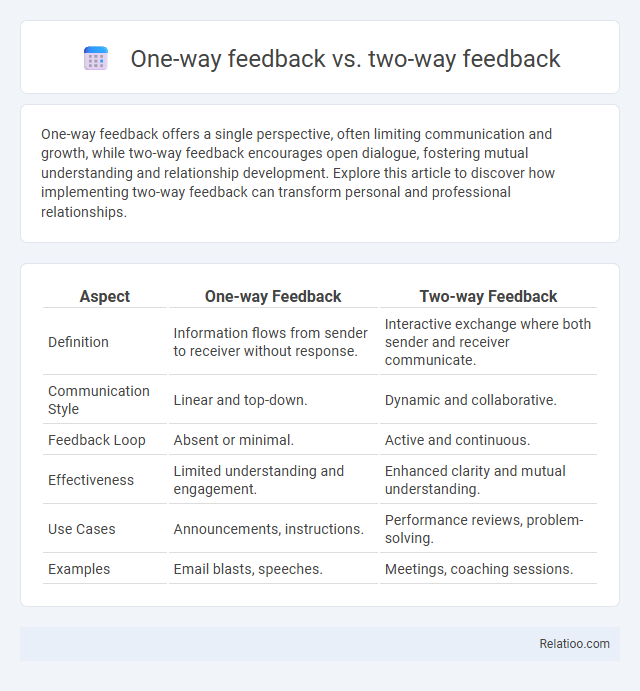One-way feedback offers a single perspective, often limiting communication and growth, while two-way feedback encourages open dialogue, fostering mutual understanding and relationship development. Explore this article to discover how implementing two-way feedback can transform personal and professional relationships.
Table of Comparison
| Aspect | One-way Feedback | Two-way Feedback |
|---|---|---|
| Definition | Information flows from sender to receiver without response. | Interactive exchange where both sender and receiver communicate. |
| Communication Style | Linear and top-down. | Dynamic and collaborative. |
| Feedback Loop | Absent or minimal. | Active and continuous. |
| Effectiveness | Limited understanding and engagement. | Enhanced clarity and mutual understanding. |
| Use Cases | Announcements, instructions. | Performance reviews, problem-solving. |
| Examples | Email blasts, speeches. | Meetings, coaching sessions. |
Understanding One-Way Feedback
One-way feedback involves transmitting information from a sender to a receiver without expecting or requiring a response, commonly used in performance reviews or instructional settings to convey assessments or guidance. This feedback method prioritizes clarity and directness but may limit opportunities for dialogue and mutual understanding. In contrast, two-way feedback encourages active interaction and exchange, while a feedback loop continuously cycles information to refine processes or behaviors.
Defining Two-Way Feedback
Two-way feedback involves an interactive exchange where both parties actively share observations, questions, and responses, fostering mutual understanding and continuous improvement. This dynamic process contrasts with one-way feedback, which is a unidirectional flow from giver to receiver without immediate dialogue. Implementing a feedback loop ensures ongoing evaluation and adjustment, but two-way feedback uniquely emphasizes reciprocal communication, making it essential for your team's development and engagement.
Key Differences Between One-Way and Two-Way Feedback
One-way feedback involves a straightforward transmission of information from a sender to a receiver without expecting a direct response or interaction, commonly used in performance reviews or instructional settings. Two-way feedback, however, enables an interactive exchange where both parties actively share insights, fostering collaboration and understanding that enhance relationship dynamics. Your ability to apply the right feedback loop depends on the context, with one-way suited for delivering concise messages and two-way promoting continuous improvement through dialogue.
Advantages of One-Way Feedback
One-way feedback offers clear, concise communication by providing straightforward information from sender to receiver, reducing the risk of confusion and streamlining decision-making processes. It enables faster responses in high-pressure environments where quick, direct instructions are essential, such as in emergency services or manufacturing lines. The simplicity of one-way feedback minimizes interruptions, making it ideal for delivering performance reviews or instructional content efficiently.
Benefits of Two-Way Feedback
Two-way feedback fosters open communication, enabling both parties to share insights and clarify expectations, which significantly improves collaboration and problem-solving. This dynamic exchange helps You receive timely adjustments and supports continuous improvement, ensuring goals align closely with performance. Unlike one-way feedback or feedback loops, two-way feedback enhances trust and engagement by making the process interactive and personalized.
Challenges of Implementing Feedback Systems
Implementing one-way feedback systems often faces challenges such as lack of engagement and failure to address recipient concerns, limiting the effectiveness of communication. Two-way feedback systems introduce complexities in ensuring active participation and managing potential conflicts between parties, requiring robust facilitation and trust-building. Feedback loops, while powerful for continuous improvement, demand consistent monitoring and real-time data integration, which can be resource-intensive and difficult to sustain over time.
Impact on Employee Engagement
One-way feedback often limits employee engagement by providing information without opportunity for response, reducing motivation and growth. Two-way feedback encourages open dialogue, fostering trust and collaboration that significantly enhances employee involvement and performance. Feedback loops create continuous improvement cycles, driving sustained engagement through real-time adjustments and reinforced communication.
Choosing the Right Feedback Approach
Choosing the right feedback approach depends on your communication goals and team dynamics. One-way feedback offers clear, direct instructions for performance improvement, while two-way feedback encourages dialogue, fostering mutual understanding and collaboration. Implementing a feedback loop ensures continuous improvement through iterative responses, enabling your team to adapt and grow efficiently over time.
Best Practices for Effective Feedback
One-way feedback involves a unidirectional flow of information from the provider to the receiver, emphasizing clarity and specificity to ensure the message is understood without distortion. Two-way feedback encourages open dialogue, fostering mutual understanding, trust, and continuous improvement through active listening and responsive communication. Implementing a feedback loop integrates both methods, promoting ongoing interaction that reinforces accountability, tracks progress, and enhances organizational learning.
Future Trends in Workplace Feedback
Future workplace feedback trends emphasize the evolution from traditional one-way feedback, where managers solely evaluate employees, toward two-way feedback systems promoting active dialogue and employee engagement. Advanced feedback loops integrate continuous data collection and AI-driven analytics to provide real-time, actionable insights that enhance performance and foster adaptive learning cultures. These innovations support personalized development paths, improved collaboration, and sustained organizational growth.

Infographic: One-way feedback vs Two-way feedback
 relatioo.com
relatioo.com